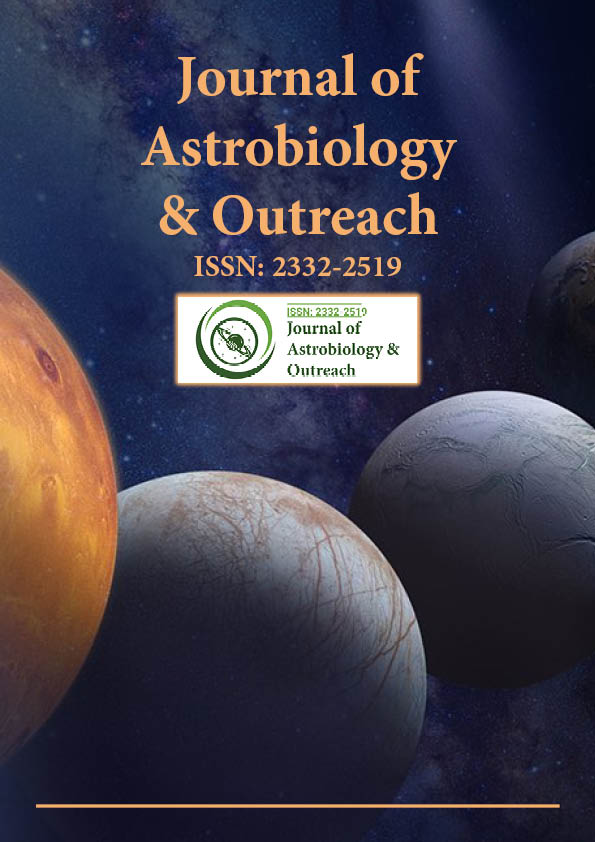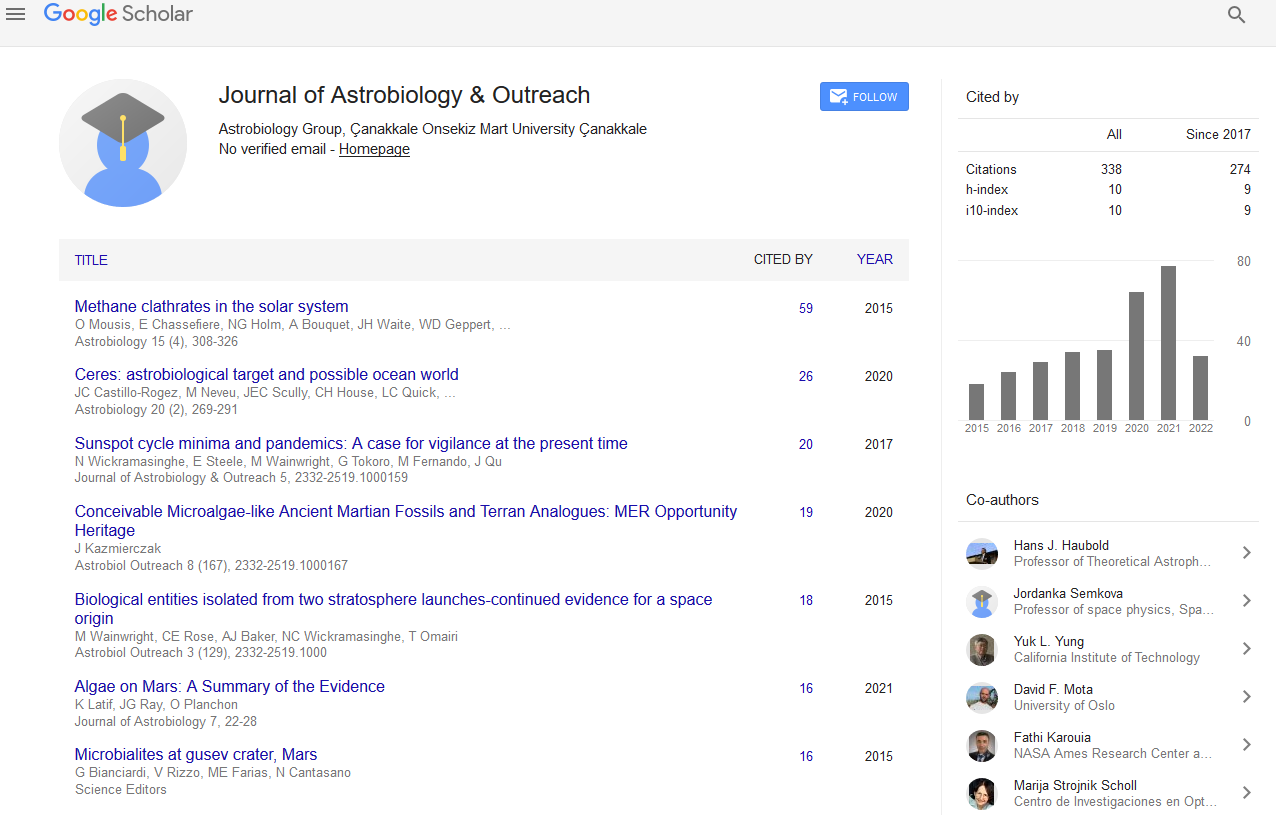Indexed In
- Open J Gate
- Academic Keys
- JournalTOCs
- RefSeek
- Hamdard University
- EBSCO A-Z
- OCLC- WorldCat
- Google Scholar
Useful Links
Share This Page
Journal Flyer

Open Access Journals
- Agri and Aquaculture
- Biochemistry
- Bioinformatics & Systems Biology
- Business & Management
- Chemistry
- Clinical Sciences
- Engineering
- Food & Nutrition
- General Science
- Genetics & Molecular Biology
- Immunology & Microbiology
- Medical Sciences
- Neuroscience & Psychology
- Nursing & Health Care
- Pharmaceutical Sciences
Commentary - (2025) Volume 13, Issue 2
Signal Amplification for Cosmic Exploration: The Low Noise Amplifier Impact on Radio Astronomy
Zheng Hao*Received: 06-Oct-2023, Manuscript No. JAO-23-23365; Editor assigned: 11-Oct-2023, Pre QC No. JAO-23-23365 (PQ); Reviewed: 26-Oct-2023, QC No. JAO-23-23365; Revised: 07-Jan-2025, Manuscript No. JAO-23-23365 (R); Published: 14-Jan-2025, DOI: 10.35248/2332-2519.24.12.351
Description
Radio astronomy is a fascinating field of study that allows scientists to explore the universe by observing radio waves emitted by celestial objects. To capture and analyze these faint signals from distant galaxies, stars, and cosmic phenomena, radio telescopes require sensitive and precise equipment. One critical component in any radio telescope system is the Low Noise Amplifier (LNA). LNAs play a pivotal role in enhancing the sensitivity of radio telescopes, enabling astronomers to make innovative discoveries.
The significant role of low noise amplifiers
Low Noise Amplifiers are electronic devices designed to amplify weak signals while adding minimal noise to the signal itself. In the context of radio astronomy, LNAs are essential for several reasons:
• Sensitivity enhancement: The universe is filled with faint radio emissions that carry valuable information about celestial objects. LNAs boost the signal strength, making it easier for radio telescopes to detect and analyze these weak signals. This heightened sensitivity allows astronomers to study objects that would otherwise remain invisible.
• Noise temperature reduction: The performance of a radio telescope is often limited by the noise temperature of its components. LNAs are engineered to have extremely low noise temperatures, helping to reduce overall system noise. As a result, astronomers can capture and analyze celestial radio signals with higher precision.
• Increased observational range: By amplifying weak signals, LNAs extend the range of observations, enabling the detection of distant and faint celestial objects. This capability is significant for studying objects at the edge of the observable universe, such as the cosmic microwave background radiation.
• Improved signal-to-noise ratio: Radio telescopes equipped with LNAs can discern faint signals from background noise more effectively. This improvement in signal-to-noise ratio enhances the quality of data collected by radio astronomers.
Challenges in designing low noise amplifiers for radio astronomy
Designing LNAs for radio astronomy applications is a complex task due to the specific requirements of the field. Here are some of the challenges faced by engineers and scientists:
• Ultra-low noise: LNAs for radio astronomy must achieve extremely low noise figures to preserve the integrity of weak radio signals. This necessitates advanced semiconductor technologies and precise component selection.
• Broad frequency coverage: Radio telescopes operate across a wide range of frequencies, from meter to millimetre wavelengths. LNAs need to be versatile and cover this entire spectrum efficiently.
• Temperature stability: Radio telescopes often operate in harsh environments, including extreme temperatures. LNAs must maintain their performance and low noise characteristics under varying conditions.
• Precision and calibration: Accurate calibration is essential for radio telescopes. LNAs must be designed with precision to ensure that the data collected is reliable and can be used for scientific analysis.
Contributions to radio astronomy
Low noise amplifiers have played a crucial role in many significant discoveries in radio astronomy. Here are a few examples:
• Cosmic Microwave Background (CMB): The detection and precise measurement of the CMB radiation, which provides valuable insights into the early universe, were made possible by LNAs with exceptional sensitivity.
• Pulsars: Radio astronomers have used LNAs to study pulsars, rapidly rotating neutron stars that emit intense beams of radiation. These observations have helped test fundamental theories of gravity and provide insights into astrophysical phenomena.
• Exoplanet detection: LNAs are instrumental in the search for exoplanets using radio techniques. The ability to detect faint radio emissions from distant planets opens up new possibilities for understanding planetary systems beyond our solar system.
Low noise amplifiers are indispensable tools in the field of radio astronomy, enabling astronomers to unlock the secrets of the cosmos. These highly sensitive devices enhance the capabilities of radio telescopes, allowing for the detection and analysis of weak radio signals from celestial objects. As technology continues to advance, it is likely that LNAs will play an even more significant role in expanding our understanding of the universe, leading to new discoveries and breakthroughs in the field of astronomy.
Citation: Hao Z (2025) Signal Amplification for Cosmic Exploration: The Low Noise Amplifier Impact on Radio Astronomy. J Astrobiol Outreach. 13:371.
Copyright: © 2025 Hao Z. This is an open access article distributed under the terms of the Creative Commons Attribution License, which permits unrestricted use, distribution, and reproduction in any medium, provided the original author and source are credited.

